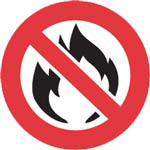It's your responsibility to make sure you don't start a fire
- On hot, dry days, exercise extreme caution before harvesting, grinding, welding, slashing or mowing
- Avoid driving vehicles and motorbikes through dry grass or crop - the risk from the hot exhaust system is high. Driving vehicles with catalytic converters through dry grass and crops is particularly hazardous
- Take regular breaks
- Make it part of your routine to check for straw or grass build-up, and hot bearings
- Check machinery to ensure that spark arrestors are maintained.
 Harvesters
Harvesters
The most common cause of harvester fires is material collecting on hot engine components such as the manifold, exhaust and turbocharger.
The key to avoiding harvester fires is diligence in clean-down and inspection. Postpone paddock work during the highest fire-risk periods.
Harvester safety checklist
- Equip your machine with at least two fire extinguishers
- Avoid overloading electrical circuits
- Use the battery isolation switch when the harvester is parked
- Use vermin deterrents as rodents can chew through electrical insulation.
Find out more: advice on preventing harvest fires
Restrictions during the Fire Danger Period
Vehicles and motorbikes propelled with an internal combustion engine must not contact any type of vegetation unless they are fitted with a system that takes all of the exhaust from the engine through a silencing device.
Machinery incorporating a heat engine in contact with, or within nine metres of crop, grass, stubble, weeds, undergrowth or other vegetation must be:
- Free from faults and mechanical defects that could cause an outbreak of fire
- Fitted with an approved spark arrester
- Carry fire suppression equipment: this can be a knapsack spray pump or water fire extinguisher. It must be in working order, fully charged with water and have a minimum capacity of nine litres
Tractors fitted with a turbocharger or an exhaust-aspirated air cleaner do not require a spark arrestor.
Cutting, welding and grinding equipment must be operated with:
- A fire-resistant shield or guard in place to stop sparks and hot material
- An area of at least 1.5 m clear of flammable material or sufficiently wet down
- A water supply or an effective water knapsack of at least nine litres capacity available
- Cut-offs and electrode stubs placed directly in a fireproof container
 On a Total Fire Ban day, the use of fire (or equipment that produces a naked flame) is banned.
On a Total Fire Ban day, the use of fire (or equipment that produces a naked flame) is banned.
Read more about what you can and can't do on days of Total Fire Ban
Chainsaws, lawn mowers and other equipment
Equipment with non-vehicle heat engines can be used in green vegetation without any conditions.
In vegetation that is not green, this equipment should only be used in the open if fitted with a spark arrester. One of the two following conditions must also be followed:
- The area around the heat engine must be clear of flammable material for a radius of at least 3m
- Someone is in attendance at all times (unless operating with a special exemption).
And:
- The person attending the fire has a working water fire extinguisher or knapsack of at least nine litres capacity.
Chainsaws, plant/grass trimmers or lawn mowers can be used in green vegetation without any conditions.
Chainsaws, plant or grass trimmers or lawn mowers used in vegetation that is not green, must be:
- Free from faults and mechanical defects that could cause an outbreak of fire
- Fitted with an efficient spark arrester
- Have an area of at least three metres around the machine cleared of flammable material.
Fire suppression equipment required:
- A knapsack spray pump, in working order, fully charged with water, with a capacity of not less than 9 litres
- A water fire extinguisher, in working order, fully charged with water, with a capacity of not less than 9 litres.
Page last updated: Tuesday, 1 October 2024 4:50:56 PM